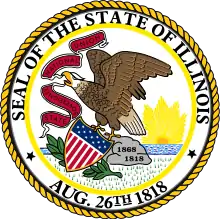William Lee D. Ewing
William Lee Davidson Ewing (August 31, 1795 – March 25, 1846) was a politician from Illinois who served partial terms as the fifth governor of the state and as U.S. Senator.
William Lee D. Ewing | |
|---|---|
 | |
| United States Senator from Illinois | |
| In office December 30, 1835 – March 3, 1837 | |
| Preceded by | Elias Kane |
| Succeeded by | Richard M. Young |
| 5th Governor of Illinois | |
| In office November 17, 1834 – December 3, 1834 | |
| Preceded by | John Reynolds |
| Succeeded by | Joseph Duncan |
| 5th Lieutenant Governor of Illinois | |
| In office March 1, 1833 – December 5, 1834 | |
| Governor | John Reynolds |
| Preceded by | Zadok Casey |
| Succeeded by | Alexander M. Jenkins |
| Member of the Illinois Senate | |
| In office 1832–1834 | |
| Member of the Illinois House of Representatives | |
| Personal details | |
| Born | August 31, 1795 Paris, Kentucky |
| Died | March 25, 1846 (aged 50) Springfield, Illinois |
| Political party | Democratic |
| Profession | Lawyer |
| Military service | |
| Branch/service | Illinois Militia |
| Rank | Major General[1] |
| Battles/wars | Black Hawk War |
Ewing was born in Paris, Kentucky and practiced law in Shawneetown, Illinois. James Monroe appointed him to be a land office receiver in Vandalia in 1820. He served as a Colonel of the "Spy Battalion" during the Black Hawk War. In 1830, he was elected to serve in the state House of Representatives as Speaker. He had previously been the clerk of the House. From 1832 to 1834, he was a State Senator, serving as President pro tempore of the State Senate in 1832. In 1833, he was also named acting Lieutenant Governor of Illinois and served as Governor of Illinois for fourteen days in 1834, the shortest gubernatorial term in Illinois history.
Upon the death of Elias Kane in 1835, Ewing was appointed by Joseph Duncan to serve out the rest of Kane's term in the U.S. Senate. In 1838 he was appointed Commissioner to adjust the claims of mixed-bloods and traders at Fort Snelling for the Dakota under the 1837 Dakota treaty. His re-election campaign was unsuccessful and he returned to the Illinois State House, becoming Speaker of the House again. He died in Springfield, Illinois.
References
- Ford, Thomas. A History of Illinois, from its Commencement as a State in 1818 to 1847. Chicago: S.C. Griggs & Co., 1854, 143. Google Books, 19 June 2010, .
External links
- United States Congress. "William Lee D. Ewing (id: E000283)". Biographical Directory of the United States Congress.
| Political offices | ||
|---|---|---|
| Preceded by John McLean |
Speaker of the Illinois House of Representatives 1830–1832 |
Succeeded by Alexander M. Jenkins |
| Preceded by Zadok Casey |
Lieutenant Governor of Illinois 1833–1834 |
Succeeded by Alexander M. Jenkins |
| Preceded by John Reynolds |
Governor of Illinois 1834 |
Succeeded by Joseph Duncan |
| Preceded by James Semple |
Speaker of the Illinois House of Representatives 1838–1842 |
Succeeded by Samuel Hackleton |
| Preceded by James Shields |
Illinois Auditor of Public Accounts 1843–1846 |
Succeeded by Thomas Hayes Campbell |
| U.S. Senate | ||
| Preceded by Elias K. Kane |
U.S. senator (Class 3) from Illinois 1835–1837 Served alongside: John M. Robinson |
Succeeded by Richard M. Young |

